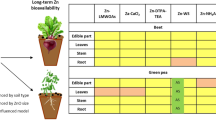Summary
As Electro-Ultra-Filtration offers the possibility for a rapid measurement of the “intensity” parameter of plant nutrients, it was examined whether or not the integration of the buffer power would improve information generated, by this technique and so an experiment was conducted to answer this question of the importance of Zn buffer power on Zn nutrition of maize. The experimental soil was dressed with graded amounts of soluble Zn and equilibrated for 15 days after which separate portions of it were extracted with DTPA to determine Zn “quantity” and by the Electro-Ultra-Filtration technique (EUF) to determine Zn “intensity”. The same soil was cropped to maize to monitor Zn uptake. At first Zn concentration in the plant top, determined by inductively coupled plasma emission spectrophotometry, and total Zn uptake by plant top, were correlated with the Electro-Ultra-Filtrable zn at seeding and at harvest as simple linear regression functions. When the corresponding Zn buffer power was also integrated into the computations as a multiple regression function, there was a remarkable improvement in the correlation coefficients so obtained and as much as 66% of the variance in Zn concentration in the plant top could be attributed to the variance in Zn “intensity” and the corresponding Zn buffer power. The Zn buffer power measures the rate of Zn replenishment around plant roots during crop growth. Since the EUF technique offers the possibility for rapid measurement of Zn “intensity”, the predictability of routine soil testing by this method could be substantially enhanced by integrating the Zn buffer power also into the computations.
Similar content being viewed by others
References
Barber S A, Walker J M and Vassey E H 1963 Mechanism for the movement of plant nutrients from the soil and fertilizer to the plant root. J. Agric. Food Chem. 11 204–207.
Cottenie A, Verloo M and Velghe G 1980 La spectrométrie d'émission à plasma inductif appliquée à l'analyse des plantes. Spectra 2000, 63, 69–74.
Drew M C, Nye P H and Vaidyanathan L V 1969. The supply of nutrient ions by diffusion to plant roots in soil. I. Absorption of potassium by cylindrical roots of onion and leek. Plant and Soil 30, 252–270.
Elgawhary S M, Lindsay W L and Kemper W D 1970 Effect of EDTA on the self-diffusion on zinc in aqueous solution and in soil. Soil Sci. Soc. Am. Proc. 34, 66–70.
Lindsay W L 1972 Zinc in soils and plant nutrition. Adv. Agron. 24, 147–186.
Nemeth K 1979 The availability of nutrients in the soil as determined by electro ultra filtration (EUF). Adv. Agron. 31, 155–188.
Nemeth K and Recke H 1982 Reproducibility of Ca, K, Na and P contents in the different EUF fractions. Plant and Soil 64, 25–33.
Nye P H 1979 Soil properties controlling the supply of nutrients to the root surface.In The Soil-Root Interface. Eds. J L Harley and R S Russell. Academic Press, London, New York, San Francisco, pp 39–49.
Wiklickly L 1982. Application of the EUF procedure in sugarbeet cultivation. Plant and Soil 64, 115–127.
Author information
Authors and Affiliations
Rights and permissions
About this article
Cite this article
Prabhakran Nair, K.P. Zinc buffer power as an important criterion for a dependable assessment of plant uptake. Plant Soil 81, 209–215 (1984). https://doi.org/10.1007/BF02197153
Received:
Revised:
Issue Date:
DOI: https://doi.org/10.1007/BF02197153




